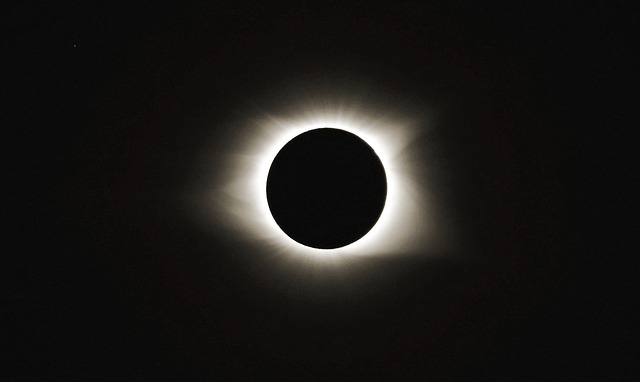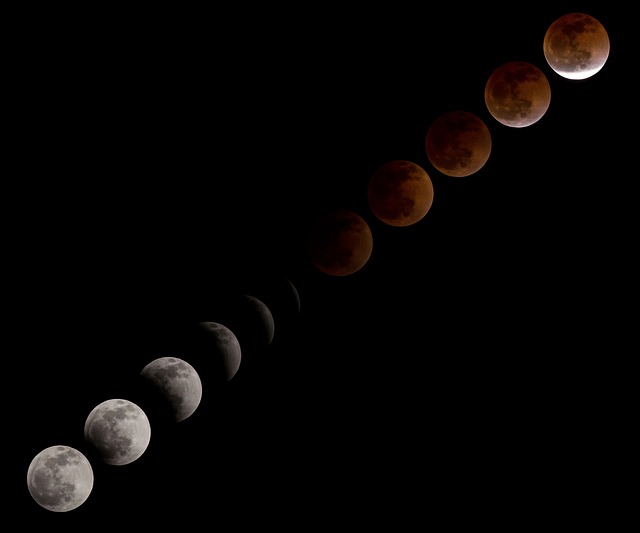
An eclipse is an astronomical event that occurs when one celestial object moves into the shadow of another. The term is most often used to describe either a solar eclipse, when the Moon’s shadow crosses the Earth’s surface, or a lunar eclipse, when the Moon moves into the shadow of Earth. However, it can also refer to such events beyond the Earth-Moon system: for example, a planet moving into the shadow cast by one of its moons, a moon passing into the shadow cast by its parent planet, or a moon passing into the shadow of another moon.
An eclipse involving the Sun, Earth and Moon can occur only when they are nearly in a straight line. Because the orbital plane of the Moon is tilted with respect to the orbital plane of the Earth (the ecliptic), eclipses can occur only when the Moon is close to the intersection of these two planes (the nodes). The Sun, Earth and nodes are aligned twice a year, and eclipses can occur during a period of about two months around these times. There can be from four to seven eclipses in a calendar year, which repeat according to various eclipse cycles, such as the Saros cycle.
Solar eclipse
An eclipse of the Sun by the Moon is termed a solar eclipse. Records of solar eclipses have been kept since ancient times. A Syrian clay tablet records a solar eclipse on May 3, 1375 BCE, while Paul Griffin argues that a stone in Ireland records an eclipse on November 30, 3340 BCE. Chinese historical records of solar eclipses date back over 4,000 years and have been used to measure changes in the Earth’s rate of spin. Eclipse dates can also be used for chronological dating of historical records.
The type of solar eclipse event depends on the distance of the Moon from the Earth during the event. A total solar eclipse occurs when the Earth intersects the umbra portion of the Moon’s shadow. When the umbra does not reach the surface of the Earth, the Sun is only partially occluded, resulting in an annular eclipse. Partial solar eclipses occur when the viewer is inside the penumbra.
Solar eclipses are relatively brief events that can only be viewed in totality along a relatively narrow track. Under the most favorable circumstances, a total solar eclipse can last for 7 minutes, 40 seconds, and can be viewed along a track that is up to 250 km wide. However, the region where partial totality can be observed is much larger. The Moon’s umbra will advance eastward at a rate of 1,700 km/h, until it no longer intersects the Earth.
During a solar eclipse, the Moon can sometimes perfectly cover the Sun because its apparent size is nearly the same as the Sun when viewed from the Earth. A solar eclipse is actually a misnomer; the phenomenon is more correctly described as an occultation of the Sun by the Moon or an eclipse of the Earth by the Moon.

Lunar Eclipse
Lunar eclipses occur when the Moon passes through the Earth’s shadow. Since this occurs only when the Moon is on the far side of the Earth from the Sun, lunar eclipses only occur when there is a full moon. Unlike a solar eclipse, an eclipse of the Moon can be observed from nearly an entire hemisphere. For this reason it is much more common to observe a lunar eclipse from a given location. A lunar eclipse also lasts longer, taking several hours to complete, with totality itself usually averaging anywhere from about 30 minutes to over an hour.
There are three types of lunar eclipses: penumbral, when the Moon crosses only the Earth’s penumbra; partial, when the Moon crosses partially into the Earth’s umbra; and total, when the Moon circles entirely within the Earth’s umbra. Total lunar eclipses pass through all three phases. Even during a total lunar eclipse, however, the Moon is not completely dark. Sunlight refracted through the Earth’s atmosphere intersects the umbra and provides a faint illumination. Much as in a sunset, the atmosphere tends to scatter light with shorter wavelengths, so the illumination of the Moon by refracted light has a red hue.
Shortened article and images from wikipedia.org. Published under the terms of the GNU Free Documentation License, Version 1.2.
